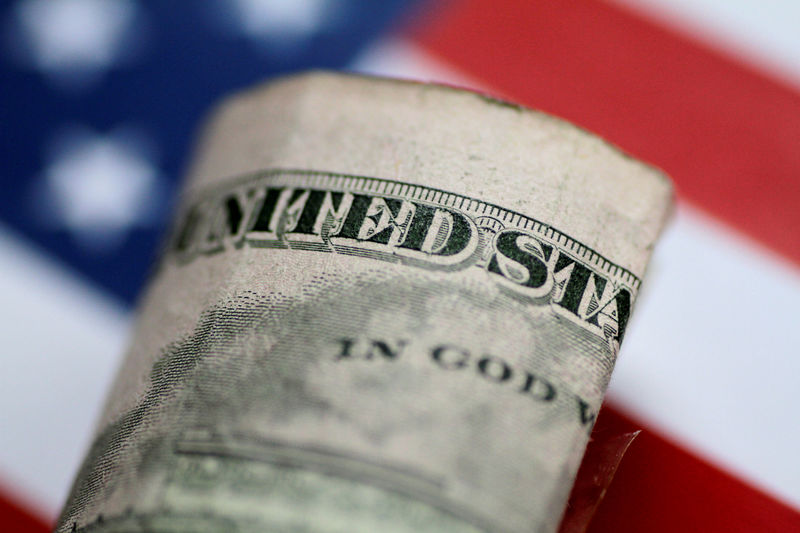
The U.S. dollar slumped further Friday, falling to an almost two-year low, on weakening confidence in the American economy as the trade war between the two largest economies in the world escalated, with China once more raising the tariffs on U.S. goods.
At 04:20 ET (08:20 GMT), the Dollar Index, which tracks the greenback against a basket of six other currencies, dropped 1.2% to 99.430, falling below the 100 level for the first time since July 2023.
U.S. President Donald Trump’s pausing of widespread tariffs for 90 days helped the dollar, and global equities, but this relief hasn’t lasted long as it didn’t include China.
Instead, he ratcheted up duties on Chinese imports to an effective 145% rate, further escalating tensions between the world’s two largest economies.
China retaliated again Friday, announcing a new 125% tariff on U.S. imports – up from the 84% announced on Wednesday.
Longer-dated U.S. Treasurys are also selling off, putting 10-year yields on course for their biggest weekly jump since 2001 as investors deserted U.S. assets, including this supposed safe haven.
“We are witnessing a simultaneous collapse in the price of all U.S. assets including equities, the dollar versus alternative reserve FX and the bond market,” said analysts at Deutsche Bank (ETR:DBKGn), in a note.
“The market has lost faith in U.S. assets, so that instead of closing the asset-liability mismatch by hoarding dollar liquidity it is actively selling down the U.S. assets themselves,” Deutsche said.
In Europe, EUR/USD traded 1.6% higher to 1.1371, with the single currency soaring to a level last seen in February 2022.
President Trump’s policies in recent weeks have eroded confidence in the U.S. dollar, European Central Bank policymaker Francois Villeroy de Galhau said on Thursday.
“The big element of constancy in U.S. policy of the past decades is the attachment to the central role of the dollar. I believe that the Trump administration also has that view, but it is very incoherent in the way it practices that. What has happened in recent days and weeks plays against the confidence in the U.S. currency,” Villeroy said.
This has resulted in demand for the euro, among other currencies like the Swiss franc and the Japanese yen.
Data released earlier Friday showed that German inflation eased to 2.3% in March, the federal statistics office said on Friday, confirming preliminary data and suggesting that inflationary pressures from the eurozone’s largest economy remain subdued.
“It’s important to note that the massive EUR/USD rally is almost entirely a function of the loss of confidence in the dollar, and not at all justified by underlying short-term rate dynamics,” said analysts at ING, in a note.
USD/CHF fell 0.9% to 0.8169, extending Thursday’s near 4% plunge, and dropping to levels not seen since January 2015.
“It appears that the market’s preference for the Swiss franc is mirroring the contained risk that the Swiss National Bank will intervene to prevent excessive CHF strength.” ING said.
“The reasoning here is that sustained, one-sided FX intervention would raise alarm bells at the US Treasury, which could then officially label Switzerland an FX manipulator and impose harsher tariffs.”
GBP/USD traded 0.7% higher to 1.3058, with sterling boosted by data showing that Britain’s economy grew at a faster rate than expected in February.
Gross domestic product grew by 0.5% on the month in February, well above the expected expansion of 0.1%, while the economy grew by 1.4% compared to a year earlier, according to data from the Office for National Statistics.
In Asia, USD/JPY traded 1.3% lower to 142.65, with the Japanese currency soaring to its strongest level in more than six months on increased demand for safe havens.
Bank of Japan Governor Kazuo Ueda also recently said that the central bank’s plan to hike rates remained on track despite growing trade uncertainty.
USD/CNY traded 0.1% higher to 7.3213, after falling sharply from an over 17-year high.
The PBOC unexpectedly set a stronger yuan midpoint fix on Friday after six straight sessions of weaker fixes, reflecting some discomfort in Beijing with persistent yuan weakness.